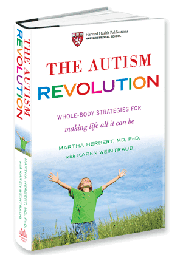As discussed under the Evidence menu item on the top menu bar, while Randomized Clinical Trials are the gold standard in Evidence Based Medieinc (EBM), this method is not ideally suited for studying physiology, dealing with heterogeneity which is huge in autism, or dealing with complex and dynamic treatments.
Here are some other research approaches. This material comes from Chapter 9, pp.213-215 of my book The Autism Revolution.
—Start of book excerpt—
Whole-body autism science: Studying complex treatments over time
We know that few if any people with autism are likely to experience major transformation from any one treatment – it usually takes a combination of many things over time. And we know that different things work for different people. So, how can we study this scientifically?
This needs systems biology, which means studying things as they interact, rather than looking at them separately.
The explosion of computer speed, data analysis techniques, portable data collection devices (like your cell phone), and lab equipment that can measure more things with smaller samples – all makes new and more flexible systems science possible. Whole-body autism needs these approaches. Here are some of them:
- Single subject, repeated measures: tracking each person over time, looking at their own rate of change, compared to themselves before. This avoids the problem of being confused by huge differences between individuals.
- Intensive longitudinal design: performing repeated measures over time at multiple levels of the web – gene expression, metabolism, lipids, immune system, gut bugs, brain blood flow, brain electricity, brain networks, behavior, learning and relatedness. This allows us to look at each person’s web, the configuration of each unique individual on the “spectrum of spectrums.”
- New methods of telehealth and electronic diaries: allowing parents, caregivers or people with autism to enter data throughout the day. This allows us to track change right as it happens.
- Wearable data monitors: using easy to wear devices that can track things like stress levels. Examining factors that increase or reduce stress can lead to solutions.
- “Omics” like genomics, metabolomics, lipidomics, proteomics, gut microbiomics and more: measuring thousands of things at one time. This allows us to look at broad changes that are occurring in many systems over time.
- Dynamic brainmeasures: looking at physiological measures likely to change with whole-body treatment, such as brain electrical signals, blood flow, metabolism, sensory processing, information processing and connectivity networks. This helps us to see what cell, tissue and information processing functions in the brain may respond to treatment, and what body changes may go along with these brain changes. Some of these may soon be trackable with wearable data monitors.
- Multileveled and nested statistical methods: using approaches that can analyze intensive information, instead of only a few variables and changes at a time. This may involve nesting (or grouping) children into doctor or therapist practices, or treatments into body or brain systems they target.
- Comparative Effectiveness Research: comparing forms of clinical practice. If some clinical approaches get consistently better outcomes than others, they can be used as role models.
- Community-Based Participatory Research: encouraging members of the community – this means you, parents and people with autism, clinicians, caregivers and more – to partner with scientists to identify problems, determine the best ways to study them, and to carry out the study.
—end of book excerpt—
Another type of research is Action Research or participatory action research, which are defined on wikipedia as a reflective process of progressive problem solving led by individuals working with others in teams or as part of a “community of practice” to improve the way they address issues and solve problems. Action research involves the process of actively participating in an organization change situation whilst conducting research.
Context-sensitive research and inquiry of these kinds may help us to move our approaches to autism to a higher, more strategic and sensitive level.


